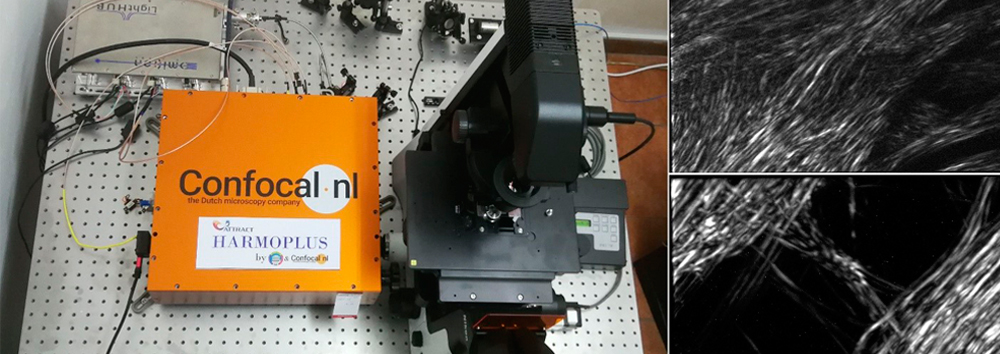©HARMOPLUS
What has the ATTRACT seed funding enabled you to do so far?
The HARMOPLUS project combines the efforts of an innovative and R&D oriented SME, Confocal.nl from The Netherlands, with those of an academic research group with significant expertise in high-resolution imaging, located at Politehnica University of Bucharest, the largest technical university in Romania, and one of the most prestigious in South-East Europe. Our aim is to extend a ground-breaking imaging technology to enable novel applications in the fields of life and materials sciences, otherwise not possible.
The work carried out until now in HARMOPLUS has resulted in a multimodal prototype system that incorporates the award-winning Re-scan Confocal Microscopy and a newly developed method for super-resolved Higher-Harmonic Generation imaging, which relies on similar principles. The latter, Re-scan Higher-Harmonic Generation Microscopy, allows the study of unlabelled biological species and advanced materials based on their intrinsic optical contrast at resolutions lying beyond the diffraction barrier. This prototype system, now available at UPB, is currently bench-marked for assessing the optimal conditions for achieving maximal resolution and sensitivity and is employed by the two teams in a series of proof-of-concept assays to showcase its superb utility and potential. One of the most important applications of Re-scan HHG (in particular of Re-scan Second-Harmonic Generation Microscopy) will consist in probing the collagen architecture of mammalian tissues, to observe subtle details that can be linked to the genesis and progression of various pathologies, unavailable to other imaging techniques due to either resolution or sensitivity limitations.
The opportunity to be at the forefront of super-resolved label-free optical imaging, and to implement high-impact experiments that showcase the advantages of a new technique is of immense benefit for both partners. It will allow UPB to extend their network of collaborators and carry out high-impact research, potentially supported by new EU and national research grants. Also, it will contribute to the prestige of Confocal.nl, which once more demonstrated their innovative spirit and their appetite for pushing forward the current boundaries of optical microscopy, while also enabling new routes for extending their portfolio of products.
What challenges have you faced so far?
As expected, in this complex endeavour several important challenges had to be addressed. One of these challenges is related to the high costs of scientific equipment. For both partners to be able to implement their planned contribution in this project, to finally result in a working prototype system, a number of important features had to be sacrificed. For example, instead of a high quantum efficiency (QE) scientific camera in the like of those that typically equip Confocal.nl’s RCM systems, we had to go for a low QE camera which limits the overall performance of the developed prototype, and hence the outputs of the proof-of-concept experiments that are currently being implemented. Furthermore, femtosecond lasers which are required for achieving the non-linear effects exploited in Re-Scan HHG, are difficult to trigger without external devices such as acusto-optic modulators, which were left out of our configuration due to their high-cost. Consequently, to avoid blurring artefacts, in the developed prototype Re-Scan HHG imaging needs to be performed at low speeds, which represents as well as limiting factor with respect to the project outputs. Also, important, the different backgrounds of the two partners raised as well some challenges. As normal for an SME, Confocal.nl is mainly preoccupied to invest time in developments that can swiftly bring added value to their portfolio of products. Conversely, the coordinating group at UPB is tempted to invest time in work that pushes forward the state-of-the art on super-resolved imaging, even if an immediate effect on market value for their SME partner is difficult to predict. Satisfying both philosophies can be at times challenging.
Where does your ATTRACT journey go from here?
The synergies developed by the two partners in this joint effort will be extended beyond the project’s lifetime to address related problems such as automated processing and analysis of Re-Scan HHG datasets, or technical developments that enhance acquisition speed, sensitivity and resolution. Collaborating with expert groups in life and material sciences to identify novel high-impact applications that harness the power of the developed method to enable new discoveries will represent an important focus as well. For this, Confocal.nl and UPB will try to identify future funding niches, such as joint research project proposals financed by EU research funds, or projects funded by other industry partners interested to develop joint intellectual property. To this end, they commend the initiative of the Attract consortium to obtain funding to potentially implement a second phase of this framework, which would allow cutting edge technologies developed in Phase-1 to be combined and result in next-generation photonic technologies and products. Depending on the final results to be achieved in HARMOPLUS, Confocal.nl considers launching a Re-scan HHG system on the international markets in a time-frame ranged from 3 to 5 years after the completion of HARMOPLUS.
Sum up in two sentences the advantages of the ATTRACT Programme over other research funding schemes.
In our eyes one of the most important advantages consists in the light-reporting requirements which allow us to focus our efforts on actual R&D activities. Also, we find very important the ATTRACT Phase-2 incentive, which stimulates ongoing Attract projects implementing complementary research to be in contact with each other, to identify valuable synergies and potential collaboration avenues and opportunities.
For more information
Visit the HARMOPLUS project site.


